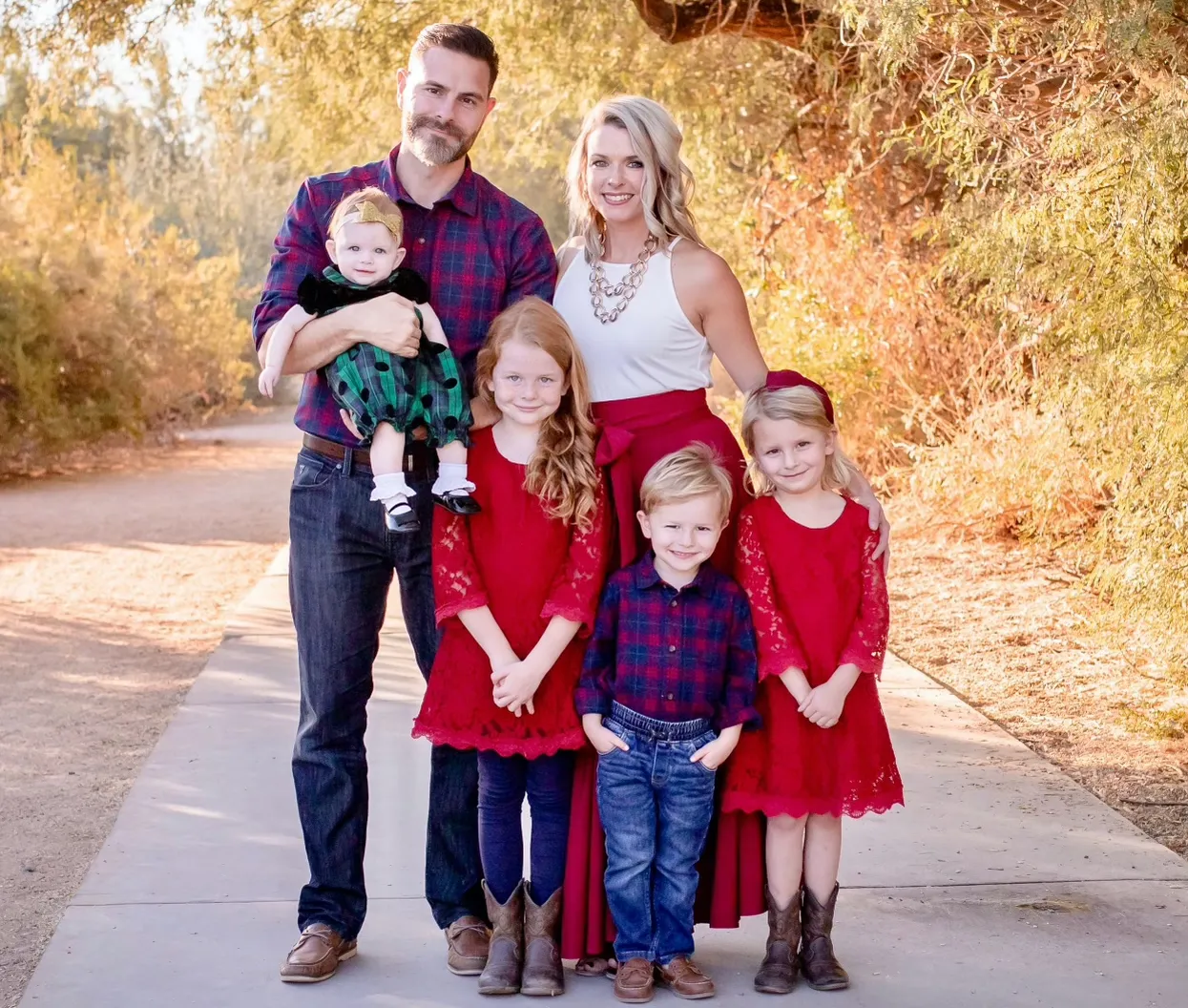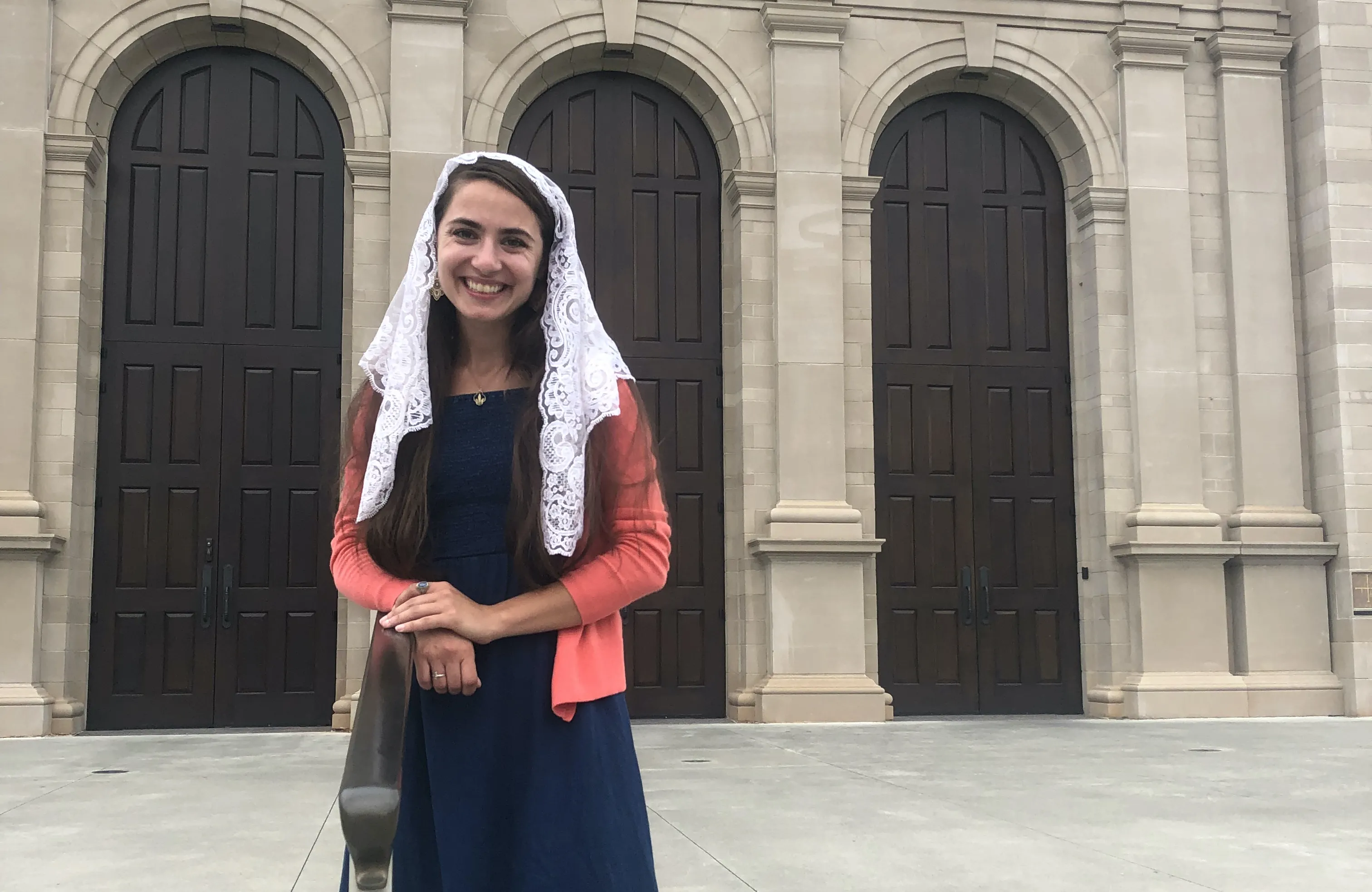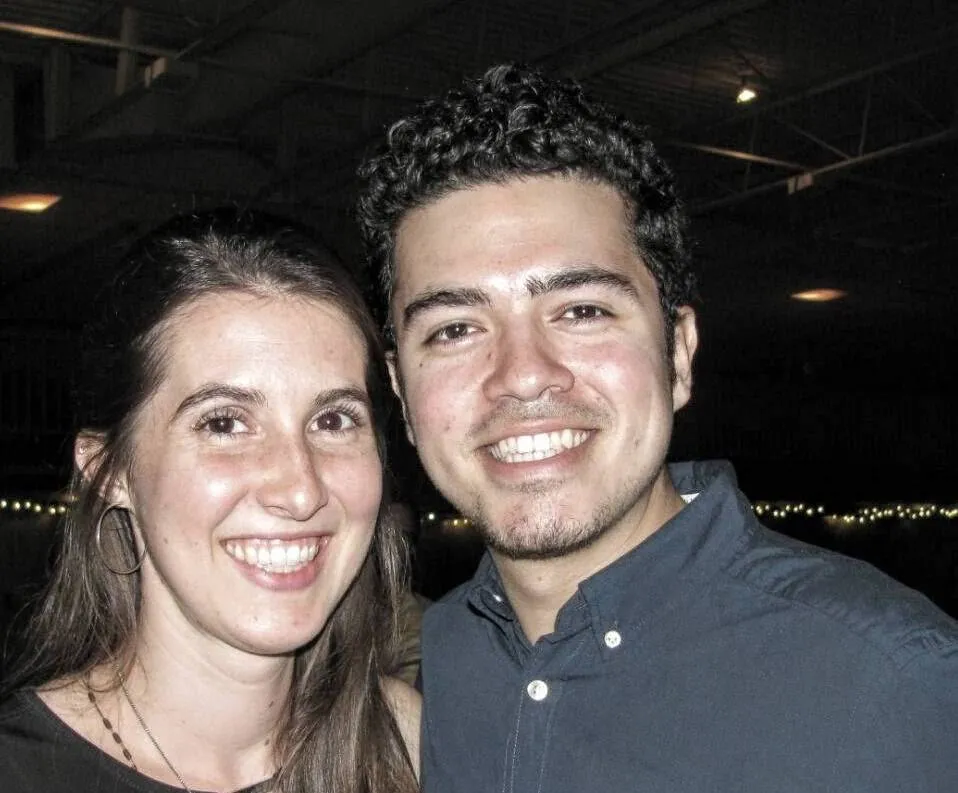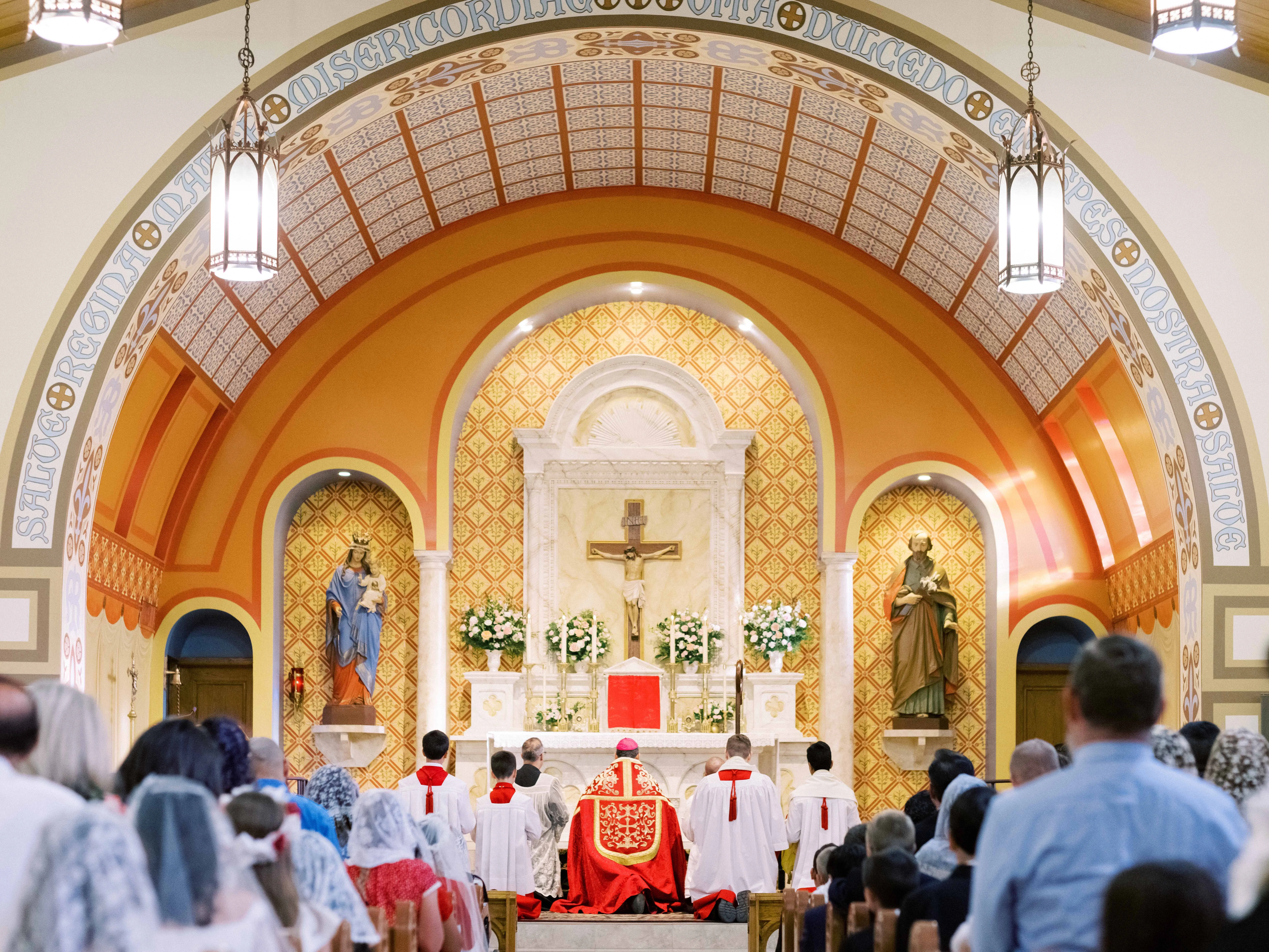
Denver Newsroom, Aug 10, 2021 / 16:32 pm (CNA).
With five children ages 10 and under to care for, and a pair of goats, a rabbit, chickens and a dog to tend to, Maureen and Matt McKinley rely on a structured routine to keep their busy lives on track.
Chores, nap times, scheduled story hours – they’re all important staples of their day. But the center of the McKinleys’ routine, what focuses their family life and strengthens their Catholic faith, they say, is the Traditional Latin Mass.
Its beauty, reverence, and timelessness connect them to a rich liturgical legacy that dates back centuries.
“This is the Mass that made so many saints throughout time,” observes Maureen, 36, a parishioner at Mater Misericordiæ Catholic Church in Phoenix.
“You know what Mass St. Alphonsus Ligouri, St. Therese, St. Teresa of Avila and St. Augustine were attending? The Traditional Latin Mass,” Maureen says.
“We could have a conversation about it, and we would have all experienced the exact same thing,” she says. “That’s exciting.”
Recent developments in the Catholic Church, however, have curbed some of that excitement. On July 16, Pope Francis released a motu proprio titled Traditiones custodis, or “Guardians of the Tradition”, that has cast doubt on the future of the Traditional Latin Mass (TLM) – and deeply upset and confused many of its devotees.
Pope Francis’ directive rescinds the freedom Pope Benedict XVI granted to priests 14 years ago to say Masses using the Roman Missal of 1962, the form of liturgy prior to Vatican II, without first seeking their bishop’s approval. Under the new rules, bishops now have the “exclusive competence” to decide where, when, and whether the TLM can be said in their dioceses.
In a letter accompanying the motu proprio, Pope Francis maintains that the faculties granted to priests by his predecessor have been “exploited to widen the gaps, reinforce the divergences, and encourage disagreements that injure the Church, block her path, and expose her to the peril of division.”
Using the word “unity” a total of 15 times in the accompanying letter, the pope suggests that attending the TLM is anything but unifying, going so far as to correlate a strong personal preference for such masses with a rejection of Vatican II.
Weeks later, many admirers of the “extraordinary” form of the Roman rite – the McKinleys among them – are still struggling to wrap their minds and hearts around the pope’s order, and the pointed tone he used to deliver it.
Maureen McKinley says she had never considered herself a “traditionalist Catholic” before. Instead, she says she and her husband have just “always moved toward the most reverent way to worship and the best way to teach our children.”
“It didn’t feel like I became a particular type of Catholic by going to Mater Misericordiæ. But since the motu proprio came out, I feel like I have been categorized, like I was something different, something other than the rest of the Church,” she says.
“It feels like our Holy Father doesn’t understand this whole group of people who love our Lord so much.”
McKinley isn’t alone in feeling this way. Sadness, anger, frustration, and disbelief are some common themes in conversations among those who regularly attend the TLM.
They want to understand and support the Holy Father, but they also see the restriction as unnecessary, especially when plenty of other more pressing issues in the Church abound.
Eric Matthews, another Mater Misericordiæ parishioner, views the new restrictions as an “attack on devout Catholic culture,” citing the beauty that exists across the rites recognized within the Church. There are seven rites recognized in the Catholic Church: Latin, Byzantine, Alexandrian or Coptic, Syriac, Armenian, Maronite, and Chaldean.
“It’s the same Mass,” says Matthews, 39, who first discovered the TLM about eight years ago. “It’s just different languages, different cultures, but the people that you have there are there for the right reasons.”

Different paths to the TLM
The pope’s motu proprio directly affects a tiny fraction of U.S. Catholics – perhaps as few as 150,000, or less than 1 percent of some 21 million regular Mass-goers, according to some estimates. According to one crowd-sourced database, only about 700 venues – compared to over 16,700 parishes nationwide – offer the TLM.
Also, since the motu proprio’s release July 16, only a handful of bishops have stopped the TLM in their dioceses. Of those bishops who have made public responses, most are allowing the Masses to continue as before – in some cases because they see no evidence of disunity, and in others because they need more time to study the issue.
But for those who feel drawn to the TLM – for differing reasons that have nothing to do with a rejection of Vatican II – it feels as if the ground has shifted under their feet.
Maureen McKinley wants her children to understand the importance of hard work, of which they have no shortage when it comes to their urban farm. After morning prayer, Maureen milks the family’s goats with the help of the children. Madeline (age 10) feeds the bunny; Augustine (7) exercises the dog; John (6) checks for eggs from the chickens; and Michael (4) helps anyone he chooses.
With a noisy clatter in the kitchen, the McKinleys eat breakfast, tidy up their rooms, and begin their daily activities. They break at 11 a.m. to head to daily Mass at Mater Misericordiæ, an apostolate of the Priestly Fraternity of Saint Peter (FSSP), where they first attended two years ago.
Matt, 34, wanted to know how the early Christians worshipped.
“The funny thing about converts is they’re always wanting more,” says Maureen, who was, at first, a little resistant to the idea of attending the TLM because she didn’t know Latin. “Worship was a big part of his conversion.”
Maureen agreed to follow her husband’s lead, and they continued to attend the TLM. What kept them coming back week after week was the reverence for the Eucharist.
“Matt had a really hard time watching so many people receive communion in the hand at the other parish,” says Maureen. “He says he didn’t want our kids to think that that was the standard. That’s the exception to the rule, not the rule.”
Reverence in worship also drew Elizabeth Sisk to the TLM. A 28-year-old post-anesthesia care unit nurse, she attends both the Novus Ordo, the Mass promulgated by St. Paul VI in 1969, and the extraordinary form in Raleigh, North Carolina, where her parish, the Holy Name of Jesus Cathedral, offers the TLM on the first Sunday of the month.
Sisk has noticed recently that more people in her area — especially young people who are converts to Catholicism — are attending both forms of the Mass. While the Novus Ordo is what brought many of them, herself included, to the faith, she feels that the extraordinary form invites them to go deeper.
“We want to do something radical with our lives,” Sisk says. “To be Catholic right now as a young person is a really radical decision. I think the people who choose to be Catholic right now, we’re all in. We don’t want ‘watered-down’ Catholicism.”

With the lack of Christian values in the world today, Sisk desires “something greater,” which she says she can tell is happening in the TLM.
Many TLM parishes saw an increase in attendance during the pandemic, as they were often the only churches open while many others shut their doors or held Masses outside. This struck some as controversial, if not disobedient to the local government. For others, it was a saving grace to have access to the sacraments.
The priests at Erin Hanson’s parish obtained permission from the local bishop to celebrate Mass all day, every day, with 10 parishioners at a time during the height of the COVID pandemic.
“We were being told by the world that church is not necessary,” says Hanson, a 39-year-old mother of three. “Our priest says, ‘No, that’s a lie. Our church is essential. Our salvation is essential. The sacraments are essential.’”
Andy Stevens, 52, came into the Church through the TLM, much to the surprise of his wife, Emma, who had been a practicing Catholic for many years. Andy was “very adamantly not going to become Catholic,” but was happy to help Emma with their children at Mass. It wasn’t until they attended a TLM that Andy began to think differently about the Church.
“He believed that you die and then there is nothing, and he never really spoke to me about becoming a Catholic,” says Emma, 48, who was pregnant with their seventh child at the time.
Andy noticed an intense focus among the worshippers, which he recognized as a “real presence of God” that he didn’t see anywhere else. After the birth of their 7th child, he joined the Church.
All 12 of the Stevens’ children prefer the TLM to the Novus Ordo.

“It’s a Mass of the ages,” says their eldest son, Ryan, 27. “I can feel the veil between heaven and earth palpably thinner.”
A native of Chicago, Adriel Gonzalez, 33, remembers attending the TLM as a child, which he did not particularly like. It was “very long, very boring,” and the people who went to the TLM were “very stiff and they could come off as judgmental” towards his family, he says.
Gonzalez, who also attended Mass in Spanish with his family, didn’t understand the differences among rites, since Chicago was a sort of “salad bowl, ethnically,” he says, and Mass was celebrated in many languages and forms.
He took a step back from faith for some time, he says, noting that he had a “respectability issue” with the Christianity he grew up with. He watched as some of his friends were either thoughtless in the way they practiced their faith, or were “on fire,” but lacked intentionality. When he did come back to the faith, it was through learning about the Church’s intellectual tradition.
He spent time in monasteries and Eastern Catholic parishes with the Divine Liturgy because there was “something so obviously ancient about it.” He decided to stay within the Roman rite with a preference for a reverent Novus Ordo.
When he moved to Ann Arbor, Michigan, Gonzalez committed to his neighborhood parish, which had a strong contingent of people who loved tradition in general. The parish instituted a TLM in the fall of 2020, when they started having Mass indoors again after the pandemic.

“If I’m at a Latin Mass, I’m more likely to get a sense that this is a time-honored practice, something that has been honed over the millennia,” he says. “There is clearly a love affair going on here with the Lord that requires this much more elaborate song and dance.”
For Eric Matthews, the TLM feels a little like time travel.
“It could be medieval times, it could be the enlightenment period, it could be the early 1900s, and the experience is going to be so similar,” he says.
“I just feel like that’s that universal timeframe – not just the universal Church in 2021 – but the universal Church in almost any time period. We’re the only church that can claim that.”
What happens now?
The motu proprio caught Adriel Gonzalez’ attention. He sought clarity about whether his participation in the extraordinary form was, in fact, part of a divisive movement, or simply an expression of his faith.
If it was a movement, he wanted no part of it, he says.
“As far as I can tell, the Church considers the extraordinary form and the ordinary form equal and valid,” says Gonzalez. “Ideally, there should be no true difference between going to one or the other, outside of just preference. It shouldn’t constitute a completely different reality within Catholicism.”
With this understanding, Gonzalez says he resonated with some of the reasoning set forth in the motu proprio because it articulated that the celebration of the TLM was never intended to be a movement away from the Novus Ordo or Vatican II. Gonzalez also emphasized that the extraordinary form was never supposed to be a “superior” way of celebrating the Mass.
Gonzalez believes the Lord allowed the growth in the TLM “to help us to recover a love for liturgy, and to ask questions about what worship and liturgy looks like.” He would have preferred if what was good was kept and encouraged, and what was potentially dangerous “coaxed out and called out.”

Erin Hanson, of Mater Misericordiæ, agrees.
“If [Pope Francis] does believe there is division between Novus Ordo and traditional Catholics, I don’t think he did anything to try to fix that division,” she says.
Hanson would like to know who the bishops are that Pope Francis consulted in making this decision, sharing that she doesn’t feel that there is any of the transparency needed for such a major document. If there are divisions, she says, she would like the opportunity to work on them in a different way.
“This isn’t going to be any less divisive if he causes a possible schism,” Hanson says.
According to the motu proprio and the accompanying letter, the TLM is not to be celebrated in diocesan churches or in new churches constructed for the purpose of the TLM, nor should new groups be established by the bishops. Left out of their parish churches, some are worried their only option to attend Mass will be in a recreation center or hotel ballroom.
Eric Matthews hopes that everyone is able to experience the extraordinary form at least once in their life so they can know that this is not about division.
“I can’t imagine someone going to the Latin Mass and saying, ‘This is creating disunity,’” he says. “There’s nothing to be afraid of with the Latin Mass. You’re just going to be surrounding yourself with people that really take it to heart.”
Maureen McKinley was home sick when her husband Matt found out about the motu proprio. He had taken the kids to a neighborhood park, where he ran into some friends who also attend Mater Misericordiæ. They asked if he had heard the news.
“I felt disgust at a document that pretends to say so much while actually saying so little and disregards the Church’s very long and rich tradition of careful legal documents,” Matt McKinley says.
Bishop Thomas Olmsted of Phoenix stated that the TLM may continue at Mater Misericordiæ, as well as in chapels, oratories, mission churches, non-parochial churches, and at seven other parishes in the diocese. Participation in the TLM and all of the activities of the parish are so important to the McKinleys that they are willing to move to another state or city should further restrictions be implemented.
For now, their family’s routine continues the same as before.
At the end of their day, the McKinleys pray a family rosary in front of their home altar, which has a Bible at the center, and an icon of Christ and a statue of the Virgin Mary. They eat dinner together, milk the goat again, and take care of their evening animal chores. After night prayer, the kids head off to bed, blessing themselves with holy water from the fonts mounted on the wall before they enter their bedroom.
“The life of the Church springs from this Mass,” Maureen says. “That’s why we’re here—not because the Latin Mass is archaic, but that it’s actually just so alive.”
Editor’s note: Several of the people interviewed here also shared their stories with the CNA Newsroom podcast, and their voices appear on Episode 107: Extraordinary Times for the Extraordinary Form. Click here to listen to the episode.
If you value the news and views Catholic World Report provides, please consider donating to support our efforts. Your contribution will help us continue to make CWR available to all readers worldwide for free, without a subscription. Thank you for your generosity!
Click here for more information on donating to CWR. Click here to sign up for our newsletter.





What’s all this stuff about obsolete “beauty, reverence, and timelessness?” In the long run, it almost sounds as if–rather than eliminating the Traditional Latin Mass–the translation of the throw-away-culture TC is DOA…
Cardinal Zen suggests that Pope Francis’ motu proprio might have originated in the Secretariat of State (although with some declawing by the Congregation for the Doctrine of the Faith, according to Archishop Vigano).
If so, then alongside Beccui litigation re past Church finances, and with “provisional” betrayal of the Church in China…does this latest gambit mean that Cardinal Parolin (both an inventor of the term “anthropological cultural change” 2016, and an open defender of natural law, 2019) is fully eliminated as a too-pragmatic papabile at the next conclave?
Two-faced Clericalism takes a hit? Maybe this time it’s the Holy Spirit, rather than the St. Galen Mafia, that is now setting the table for the next conclave and for ongoing curial reorganization, both.
Cultural Anthropology and the jettison of liturgical tradition to defend tradition is raised here by Peter D Beaulieu attributing invention of the terminology to Vat Secy of State Cardinal Parolin 2016. Perhaps invention insofar as its ecclesial usage. “Our mission is to improve human health and wellbeing by encouraging and promoting innovation, new partnerships and advancing greater public awareness of the power of prevention and preparedness. We will explore the relationship between the mind, body and soul and the anthropological and cultural dimensions of being human” ( A Global Health Care Initiative and Novel Delivery Systems Fifth Internat Vat Conf 5.6.21) First, the question why is cultural change now a pedantic cultural anthropological change? Cultural anthropology is defined as adaptation, discovery of innovative means for improvement. Only Man produces culture. And cultural change definitively incorporates innovation. Anthropology added to the equation suggests anthropological change, an impossibility. That is if our definition of anthropology is human nature ordained by God and ordered by natural law [natural law a reflection of eternal law]. Any scientific study, even exploration of new dimensions of reality has potential value. Although invention of new oxymoron terminology speaks to other than observational science, rather intent to add ideology. Evolutionary change immediately comes to mind in respect to anthropology. “A distinctive social or cultural anthropology emerged in the 1920s. It was associated with the social sciences and linguistics, rather than with human biology and archaeology. In Britain in particular social anthropologists came to regard themselves as comparative sociologists, but the assumption persisted that anthropologists were primarily concerned with contemporary hunter-gatherers or pastoralists, and in practice evolutionary ways of thinking may often be discerned below the surface of functionalist argument that represents itself as ahistorical (Britannica). Evolutionary ways of thinking immanent and ahistorical does speak to inherent process. As with the increasingly apparent evaluation of adult homosexual relations liturgical change seems perceived as evolutionary growth, in current ideological terms fraternal globalization.
Some trad with big bucks paid a lot for this propaganda piece posing as news. They were careful to hit all the “correct” talking points and make 1962 Mass devotees seem sympathetic. Slyly-crafted, I must say. But that’s what makes it so obvious as propaganda instead of news.
Fact is that the Church decreed a reform of the liturgy to improve the ecclesiology expressed in the Mass. The pre-conciliar Mass is exclusively clerical. You don’t even need the congregation. In the post-conciliar Mass, the People of God are more clearly liturgical participants.
There is no place for the outdated clerical Mass in the post-Vatican II Church. The new Mass can be celebrated with reverence, and it should be. Go to that.
And your advertisement for the Hermeneutic of Rupture was paid for by….?
The long and short of your stance is simple: the times (that is, the secular realm) dictate the nature of the Church (“outdated…”). Never mind that “The world was created for the sake of the Church” (CCC 760). The term “clerical” is tossed about to appeal to readers who are inclined to vague equity rather than real equality in authentic diversity. One can be aware of certain emphases and faults of previous eras without giving into the even worse faults and skewed emphases of the current age.
I don’t write this as a TLM guy. I’ve been in a Greek Catholic parish since the late 1990s. Ah, the clericalism there! Horror of horrors. Thank God, the post-conciliar liturgists weren’t able to get to the Divine Liturgy. Oddly enough, we both recognize and embrace Vatican II and adhere to a Rite that I’m sure would trigger a panic attack in most post-modern, anti-clerical Rupturites.
The Catholic Church connected to Christ and his apostles has three sources of authority: scripture, tradition and office.
The label “trad” you employ toward Catholic people who have respect for tradition seems to indicate the malice and meanness of the motivations inspiring the authors of Traditiones Custodes, men who treat scripture and tradition like these are their personal property, and assert themselves as the sole source of authority.
The authors of TC are now in very stark contrast to the liberality of Pope Benedict, and have exposed themselves as miserly and impoverished men.
Response to Carl King:
You write: “The pre-conciliar Mass is exclusively clerical. You don’t even need the congregation.” And maybe that is exactly the point—the uncomprehending use of the terms “exclusively” and “congregation.”
FIRST, under the Apostolic Succession and the sacrament of Holy Orders, the Mass is not “exclusively” dependent upon the priest validated by a local congregation. Instead, the entire communion of saints is always and already present at each Mass.
And, SECOND, the reality is that the particular (not “local”) diocese/parish and entire universal Church is an “assembly” drawn together by the Eucharist Presence (not the other way around). The notion that the church is reduced to a “congregation” is Lutheran and no longer even needs the sacrament of Holy Orders as historically instituted by Christ (not by the so-called congregation or by the Holy Spirit apart from the incarnate Christ).
Pope Benedict offered CLARIFICATIONS about Luther’s pivotal apostasy, e.g.: “The center of the oldest ecclesiology is the Eucharistic [‘] assembly [’] – the Church is communion… [but with Luther] The priesthood is reduced to that of preaching, a ‘purely functional interpretation of the office…In consequence, the whole context of communio is abolished and only the ‘speakers’ are left” (Joseph Ratzinger, “Principles of Catholic Theology,” San Francisco: Ignatius, 1987, 254, 262). [Enter stage left, the “presider”!, and y’all hold hands now!!]
The PROBLEM, then, is that the Council’s balanced integration of the vertical (sic “clerical”) with the horizontal (yes, the “universal call to holiness”) was corrupted by illegitimate experimentation following the Council. Much has been cleaned up since then, but none of this would have happened if the Council document—however much influenced by the Freemason Bugnini, etc.—had been faithfully followed.
Today, “Eucharistic coherence” must not be distracted by the new sideshow pitting the perennial Latin Mass against the (long-time adulterated) Novus Ordo. It will help, for example, when the bogus term “Eucharistic Ministers” no longer displaces the authentic “Extraordinary Ministers of Holy Communion.”
An example, here, of the fine art of AMBIGUITY, well-exploited especially in recent years…
In 1967 Pope Paul VI declared that the Novus Ordo is valid IF the ambiguous wording is understood in the orthodox sense—this after he had inserted corrective amendments to the too-open-ended rendition under Archbishop Annibale Bugnini. (English writer Michael Davies claimed that Pope Paul VI in 1976 sent Bugnini to Iran as nuncio due to alleged documentation that he was a Freemason.)
In “The Ratzinger Report” (1985), the later Pope Benedict pointed to the replacement of “my” with “our” in the original wording (Domini Jesu Christe…Ne respicias peccata men, sed fidem Ecllesiae tuae) still rendered today to read “Lord Jesus Christ, look not upon OUR [no longer MY] sins, but upon the faith of your Church.” He acknowledges that the “our” can also be understood as “my,” BUT then explains:
“…the use of the singular is an allusion to the necessity of a PERSONAL [italics] conversion which today is very often hidden in the anonymous mass of ‘We’, of the group, of the ‘system’, of humanity [….] the alteration here does nevertheless reinforce the contemporary tendency to diminish personal responsibility.”
The relevance of this example TODAY, is that “Eucharistic coherence” includes personal conversion and the sacrament of Penance. The interior life (“interior life”…what’s that?). As for “active participation” in the Novus Ordo, Ratzinger noted the depth of real participation that is afforded by silence (“silence”…what’s that?). ”Many liturgies now lack all trace of this silence.”
Some clericalists say that attention to Eucharistic coherence should be delayed (Cupich, Gregory, Tobin, McElroy). Consistent shepherds observe the obvious—-that Eucharistic coherence already has been DELAYED at least 36 years! (Again, “The Ratzinger Report” was published in 1985.)
I think more and more people are going to be discovering the TLM, thanks to Pope Francis’ ill-advised move. The Lord works in mysterious ways or so I’ve heard.